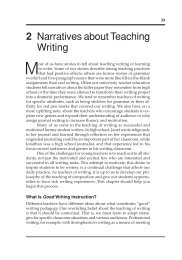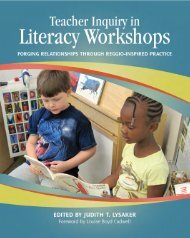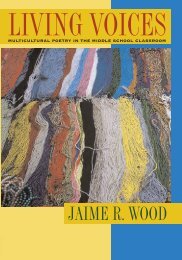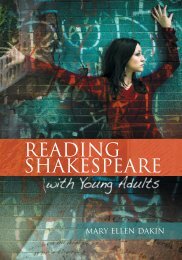Graphic novel Spread - National Council of Teachers of English
Graphic novel Spread - National Council of Teachers of English
Graphic novel Spread - National Council of Teachers of English
- No tags were found...
Create successful ePaper yourself
Turn your PDF publications into a flip-book with our unique Google optimized e-Paper software.
Introduction—Carving a Niche 9<br />
excellent educational value and special role in getting female students<br />
interested in the sciences (the book details the contributions <strong>of</strong> women<br />
scientists around the world).<br />
Timothy Morrison, Gregory Bryan, and George Chilcoat corroborate<br />
much <strong>of</strong> what Schwarz asserts in their article “Using Student-Generated<br />
Comic Books in the Classroom” (2002). They believe that “popular<br />
culture is integral to the lives <strong>of</strong> most middle school students. Use<br />
<strong>of</strong> popular culture can, therefore, diminish the disparity children perceive<br />
between their lives in and out <strong>of</strong> school by legitimizing their after<br />
school pursuits” (p. 738; Buckingham, 1998). This line <strong>of</strong> thinking, <strong>of</strong><br />
course, fits well into progressive and cultural literacy theories. The authors<br />
suggest that teachers tap into this aspect <strong>of</strong> comics and graphic<br />
<strong>novel</strong>s by having students create their own comic books:<br />
It is evident that comics are familiar to and popular with middle<br />
and high school students. The comic is a form <strong>of</strong> literature these<br />
students enjoy. Given the opportunity to create and share their<br />
own comic books, students engage in greater literacy exploration<br />
than they otherwise would, due to comics’ popular and easily<br />
accessible format. (p. 759)<br />
Again, the tie to the constructivism <strong>of</strong> progressive literacy is obvious.<br />
The authors conclude by mentioning the students’ enthusiasm for the<br />
projects and providing a reminder that such activities engage in crosscurricular<br />
pursuits by embracing “language arts, visual arts, and content<br />
areas” (p. 767).<br />
Education Week has continued the trend <strong>of</strong> exploring graphic <strong>novel</strong>s<br />
as a means <strong>of</strong> engaging reluctant readers (Ingram, 2003; Galley, 2004).<br />
Stephen Cary has published Going <strong>Graphic</strong>: Comics at Work in the Multilingual<br />
Classroom (2004) as further evidence <strong>of</strong> the medium’s effects on<br />
TESL/TEFL populations. <strong>English</strong> Journal is coming around to graphic<br />
<strong>novel</strong>s and giving some much needed serious attention to their use by<br />
practicing teachers. Nancy Frey and Douglas Fisher shared their success<br />
in using graphic <strong>novel</strong>s as scaffolding devices in their teaching <strong>of</strong><br />
high school writing (January 2004, p. 19). Indeed, their article “Using<br />
<strong>Graphic</strong> Novels, Anime, and the Internet in an Urban High School” won<br />
NCTE’s Farmer Award for Outstanding Writing. We are fortunate to<br />
reprint that essay herein and to have them contributing a new essay as<br />
well that gives teachers a great structural guide to using graphic <strong>novel</strong>s<br />
in a fully textually integrated <strong>English</strong> language arts classroom. Jodi<br />
Leckbee wrote in <strong>English</strong> Journal that graphic <strong>novel</strong>s are great for helping<br />
students transcend their apathy for reading (May 2004, p. 21) in response<br />
to the posed question “What activity has been most effective in
















